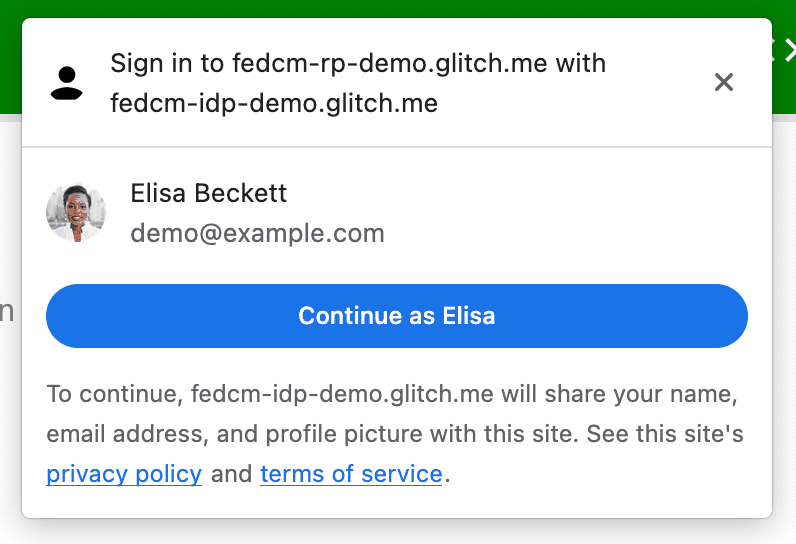Chrome supports auto-reauthentication in FedCM
Federated Credential Management API (FedCM) is a web API for privacy-preserving identity federation. With identity federation, an RP (relying party) relies on an IdP (identity provider) to provide the user an account without requiring a new username and password.
FedCM allows the browser to understand the context in which the RP and IdP exchange information. It informs the user about the information and privilege levels being shared and prevents unintended abuse. FedCM has been available in Chrome since version 108.
In Chrome 115, FedCM is getting support for auto-reauthentication which improves the user experiences and enables a more streamlined reauthentication to the RP after the initial consent.
Auto-reauthentication
Currently, after a user has created a federated account on an RP with an IdP via the FedCM API, the next time they visit the website they need to go through the same steps in the user interface. That means the user will need to explicitly and manually re-confirm to reauthenticate and proceed with the sign-in flow.
While the explicit user experience makes sense before the user has created the federated account to prevent tracking (which is one of the main goals of FedCM), it is unnecessarily cumbersome after the user has gone through it once: after the user grants permission to allow communication between the RP and the IdP, there's no privacy or security benefit for enforcing another explicit user confirmation for something that they have already previously acknowledged. That's why we are introducing a more streamlined UX that RPs can choose for their returning users.
FedCM auto-reauthentication ("auto-reauthn" in short) can let users reauthenticate automatically, when they come back after their initial authentication using FedCM. "The initial authentication" here means the user creates an account or signs into the RP's website by tapping on the "Continue as..." button on FedCM's sign-in dialog for the first time on the same browser instance.

Choose an option for auto-reauthn
While we are introducing auto-reauthn to provide better UX and to align with the
specification, the default user experience will be different without any code
change. With auto-reauthn available, the browser changes its behavior depending
on the option you select in the mediation option developers provide with
navigator.credentials.get().
const cred = await navigator.credentials.get({
identity: {
providers: [{
configURL: "https://idp.example/fedcm.json",
clientId: "1234",
}],
},
mediation: 'optional', // this is the default
});
The mediation is a property in the Credential Management
API,
it behaves in the same
way as it
does for
PasswordCredential
and
FederatedCredential
and it's partially supported by
PublicKeyCredential
as well. The property accepts the following four values:
'required': Always requires a mediation to proceed, for example, clicking the "Continue" button on the UI. Choose this option if your users are expected to grant permission explicitly every time they need to be authenticated.'optional'(default): Auto-reauthn if possible, requires a mediation if not. We recommend choosing this option on the sign-in page.'silent': Auto-reauthn if possible, silently fail without requiring a mediation if not. We recommend choosing this option on the pages other than the dedicated sign-in page but where you want to keep users signed in—for example, an item page on a shipping website or an article page on a news website.'conditional': Used for WebAuthn and not available for FedCM at the moment.
With this call, auto-reauthn happens under the following conditions:
- FedCM is available to use. For example, the user has not disabled FedCM either globally or for the RP in the settings.
- The user used only one account with FedCM API to sign into the website on this browser.
- The user is signed into the IdP with that account.
- The auto-reauthn didn't happen within the last 10 minutes.
- The RP hasn't called
navigator.credentials.preventSilentAccess()after the previous sign in.
When the above conditions are met, an attempt to automatically reauthenticate
the user starts as soon as the FedCM navigator.credentials.get() is invoked.
Enforce mediation with preventSilentAccess()
Auto-reauthenticating users immediately after they sign out would not make for a very good user experience. That's why FedCM has a 10-minute quiet period after an auto-reauthn to prevent this behavior. This means that auto-reauthn happens at most once in every 10-minutes unless the user signs back in within 10-minutes. The RP should call navigator.credentials.preventSilentAccess() to explicitly request the browser to disable auto-reauthn when a user signs out of the RP explicitly, for example, by clicking a sign-out button.
function signout() {
navigator.credentials.preventSilentAccess();
location.href = '/signout';
}
Users can opt-out of auto-reauthn in settings
Users can opt-out from auto-reauth from the settings menu:
- On desktop Chrome, go to
chrome://password-manager/settings> Sign in automatically. - On Android Chrome, open Settings > Password Manager > Tap on a cog at the top right corner > Auto sign-in.
By disabling the toggle, the user can opt-out from auto-reauthn behavior all together. This setting is stored and synchronized across devices, if the user is signed into a Google account on the Chrome instance and synchronization is enabled.
Share feedback
If you are testing FedCM you can share your feedback or any issues you run into at crbug.com under a component "Blink>Identity>FedCM".
Photo by Noah Samuel Franz on Unsplash
